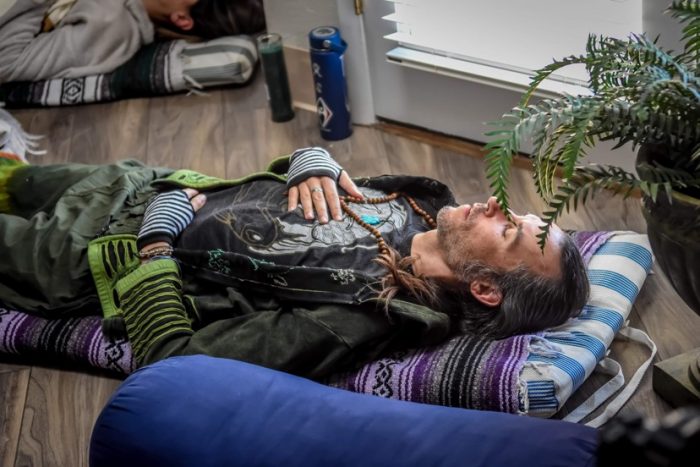Does it make you uncomfortable to see someone cry in public? Have you ever wondered why?
Our culture teaches us to hide negative emotions, especially sadness. Although the stigma of crying might be greater for men, women are also discouraged from displaying too much sorrow in public.
Most of us never learn how to simply sit with our negative emotions as they arise, to allow our physical and emotional bodies to fully experience and process the emotions. Instead, we learn to repress those emotions, to stuff them deep down inside until they come out sideways or explode in a crippling breakdown.
One of my earliest memories of repressing sadness happened in first grade when my class watched “Old Yeller.” Anyone who’s seen this movie knows what I’m talking about. I had to close my eyes and make lalala-noises in my head to drown out the epic sadness unfolding on the screen, lest I succumb to the sin of crying in front of my peers.
By the time I left for college, I had mastered the art of repressing emotions.
When the big day came, my mom, dad, and sister all drove down with me to my new home at Wabash College, a tiny liberal arts school in central Indiana. Wabash has the dubious distinction of being one of two remaining all-male four-year colleges in the United States. It was a tad bit like “Dead Poets Society,” but not as formal and no uniforms.
All day long, I could feel a host of emotions roiling within me surrounding the impending departure of my family.
This was a big occasion: leaving home, leaving the family I had lived with for my first 18 years of life, moving into a strange room, in a strange town, with a stranger as a roommate. I was dreading it—not the act of them leaving, but dreading these emotions that threatened to erupt out of control where others might see.
The activity of moving my belongings into my room helped divert my attention, and then there were separate activities for family and new students, but the impending departure could only be delayed for so long. My family had to leave early while I was in a meeting with other freshmen, which meant our goodbyes took place in a hallway outside a classroom full of my future peers, to which I had to immediately return.
That was when I learned I could completely repress all hints of sadness. Knowing I had to return to this room full of guys in this bastion of manliness, my emotions instinctively went into total lockdown. I didn’t even have to choke back tears, and the emotions were completely buried. As we said our goodbyes with awkward hugs, all of us were completely dry-eyed—like perfect models of our stoic German Lutheran heritage.
When I returned to the classroom, acting like everything was fine, I remember feeling relieved that I made it through that experience without making a scene. Relieved and numb—but numb was better than crying in public.
I’m guessing many, many of you readers can relate to this experience. We’re so used to repressing our emotions that most of us don’t even realize we’re doing it. We’re so used to our emotional bodies being completely clogged with suppressed feelings that we don’t know there is an alternative.
Recently, I discovered the magic of breathwork for accessing and processing repressed emotions. By breathwork, I don’t mean the five minutes of pranayama you might have experienced in a yoga class.
Breathwork journeys (also called breathwork circles or sessions) are a whole different animal.
I’ve only attended a handful so far, so I’m no expert, but the format I’ve seen involves a group of people lying in a circle, usually surrounding a central shrine containing various meaningful objects. Burning sage and soothing music in the background typically round out the environment.
The facilitators demonstrate a breathing technique, in my experience, a simple, rolling breath pattern that involves full, deep breaths with no pause in between inhales or exhales. The pattern feels a little forced at first, but it’s easy to get used to.
Then we simply breathe for 45 minutes to an hour, and that’s when the magic happens.
In my first three circles, I only experienced physical sensations: a buzzing, tingling sensation that started in the center of my chest and spread throughout my body, building in intensity until I stopped breathing and floated in a profound stillness for seemingly endless minutes.
Although those first experiences were profoundly peaceful for me, the sounds I heard around me indicated the other participants were having wildly different experiences—crying, sobbing, moans of agony. As I laid there with my eyes closed, I could feel explosive releases of emotion bubbling up all around me. I didn’t understand what was happening or why, but I could feel the significance of it: the catharsis, the discharge of intense feelings.
However, I didn’t experience that release of emotion until I attended a weekend retreat led by the dynamic brother-sister team of Danny and Aja Rose of Inner Light Revival. As an added delight, the breathwork sessions featured live music performed by Yaima. There, at the mystical Everland Eco-Retreat in the foothills of the Rockies near Denver, I connected with my lifetime of repressed sadness.
In our first breathwork session on Friday afternoon, I was breathing away, soaking in the ethereal melodies of Yaima, feeling those physical tingling sensations, but then something new happened. I don’t know how or why, but I started feeling the isolation and separation of a year of social distancing, feeling the years longing for a romantic relationship, and my failing attempts to spiritually bypass that longing, feeling a lifetime of suppressed emotions—and I started crying.
Instead of choking back those tears, I gave into them, allowing them to flow.
At one point, Danny knelt beside me and placed his hand on my left shoulder. He asked me, “In one word, describe what you’re feeling.” My answer: “Lonely.”
Loneliness that I didn’t want to acknowledge I was feeling. There, in that space surrounded by strangers, I felt allowed to fully acknowledge my sadness.
The silent tears swelled into full-body sobs as I opened to my sea of internalized emotion. I felt a sweeping sense of physical release and relief as I let the sorrow surface. Somehow, being around other people and feeling Danny witness my release enhanced the experience. There is some added benefit to releasing these emotions in a group setting, sharing our pent-up feelings with others, and feeling our sadness accepted by others.
As the session wrapped up, I could feel there was more emotion that still needed to come out. With great effort, I pulled myself back into my body as we slowly turned on our sides, then eased up into sitting. They encouraged us to start moving to the music, slowly, to integrate the emotions, but I had to sit still for several minutes, simply recollecting myself, to bring myself back from that sea of repressed emotions.
Although I had only broken through the surface, that release of emotions helped me feel lighter, more in touch with myself. A much fuller release happened later, rather spontaneously, during the wee hours of the morning in the arms of a caring stranger—I’ll tell that story next.
In the meantime, if anything I just described resonates with you, I encourage you to look into breathwork. It’s growing in popularity, which means insincere charlatans will inevitably pop up hoping to capitalize on the latest fad. But support for genuine emotional processing is out there, and we simply need to look for it and allow our intuition to guide us to it.
So if you’re intrigued, start looking. As I mentioned, Inner Light Revival is the real deal, and the previous circles I attended were led by people from Breathwave, which is also legit.
You may have heard of the rising popularity of Wim Hoff–his YouTube videos have helped lead me to beneficial breathing sessions on my own and can be a good starting point.
Healing is out there; trust your intuition to guide you to it.
Google “breathwork” in your area, ask around at yoga and massage studios, listen to the little voice in your head as you examine possibilities.
We can all find what we need when we allow ourselves to receive it.
~









Read 48 comments and reply